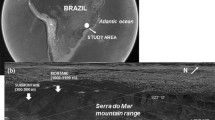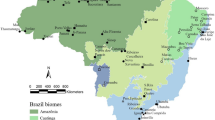Abstract
δ13C values of C3 plants are indicators of plant carbon–water relations that integrate plant responses to environmental conditions. However, few studies have quantified spatial variation in plant δ13C at the landscape scale. We determined variation in leaf δ13C, leaf nitrogen per leaf area (Narea), and specific leaf area (SLA) in April and August 2005 for all individuals of three common woody species within a 308 × 12-m belt transect spanning an upland–lowland topoedaphic gradient in a subtropical savanna in southern Texas. Clay content, available soil moisture, and soil total N were all negatively correlated with elevation. The δ13C values of Prosopis glandulosa (deciduous N2-fixing tree legume), Condalia hookeri (evergreen shrub), and Zanthoxylum fagara (evergreen shrub) leaves increased 1–4‰ with decreasing elevation, with the δ13C value of P. glandulosa leaves being 1–3‰ higher than those of the two shrub species. Contrary to theory and results from previous studies, δ13C values were highest where soil water was most available, suggesting that some other variable was overriding or interacting with water availability. Leaf Narea was positively correlated with leaf δ13C of all species (p < 0.01) and appeared to exert the strongest control over δ13C along this topoedaphic gradient. Since leaf Narea is positively related to photosynthetic capacity, plants with high leaf Narea are likely to have low p I/p a ratios and therefore higher δ13C values, assuming stomatal conductance is constant. Specific leaf area was not correlated significantly with leaf δ13C. Following a progressive growing season drought in July/August, leaf δ13C decreased. The lower δ13C in August may reflect the accumulation of 13C-depleted epicuticular leaf wax. We suggest control of leaf δ13C along this topoedaphic gradient is mediated by leaf Narea rather than by stomatal conductance limitations associated with water availability.



Similar content being viewed by others
References
Adams MA, Grierson PF (2001) Stable isotopes at natural abundance in terrestrial plant ecology and ecophysiology: an update. Plant Biol 3:299–310
Anderson JE, Williams J, Kriedemann PE, Austin MP, Farquhar GD (1996) Correlations between carbon isotope discrimination and climate of native habitats for diverse eucalypt taxa growing in a common garden. Aust J Plant Physiol 23:311–320
Archer S (1995) Tree–grass dynamics in a Prosopis-thorn scrub savanna parkland: reconstructing the past and predicting the future. Ecoscience 2:83–89
Arthur G, Stefan S, Andreas M, Helmut M, Heinz R, Mark AA (2001) Radiation modifies the effect of water availability on the carbon isotope composition of beech (Fagus sylvatica). New Phytol 150:653–664
Baldocchi DD, Bowling DR (2003) Modelling the discrimination of 13CO2 above and within a temperate broad-leaved forest canopy on hourly to seasonal time scales. Plant Cell Environ 26:231–244
Barnes PW, Archer S (1996) Influence of an overstorey tree (Prosopis glandulosa) on associated shrubs in a savanna parkland: implications for patch dynamics. Oecologia 105:493–500
Barnes PW, Archer S (1999) Tree–shrub interactions in a subtropical savanna parkland: competition or facilitation? J Veg Sci 10:525–536
Berry SC, Varney GT, Flanagan LB (1997) Leaf δ13C in Pinus resinosa trees and understory plants: variation associated with light and CO2 gradients. Oecologia 109:499–506
Booth MS, Stark JM, Rastetter E (2005) Controls on nitrogen cycling in terrestrial ecosystems: a synthetic analysis of literature data. Ecol Monogr 75:139–157
Boutton TW, Archer SR, Midwood AJ, Zitzer SF, Bol R (1998) δ13C values of soil organic carbon and their use in documenting vegetation change in a subtropical savanna ecosystem. Geoderma 82:5–41
Boutton TW, Archer SR, Midwood AJ (1999) Stable isotopes in ecosystem science: structure, function and dynamics of a subtropical savanna. Rapid Commun Mass Spectrom 13:1263–1277
Comstock J, Ehleringer J (1993) Stomatal response to humidity in common bean (Phaseolus Vulgaris): implications for maximum transpiration rate, water-use efficiency and productivity. Aust J Plant Physiol 20:669–691
Conte MH, Weber JC, Carlson PJ, Flanagan LB (2003) Molecular and carbon isotopic composition of leaf wax in vegetation and aerosols in a northern prairie ecosystem. Oecologia 135:67–77
Coplen TB (1996) New guidelines for reporting stable hydrogen, carbon, and oxygen isotope-ratio data. Geochim Cosmochim Acta 60:3359–3360
Cordell S, Goldstein G, Meinzer FC, Handley LL (1999) Allocation of nitrogen and carbon in leaves of Metrosideros polymorpha regulates carboxylation capacity and δ13C along an altitudinal gradient. Funct Ecol 13:811–818
Cornwell WK, Bhaskar R, Sack L, Cordell S, Lunch CK (2007) Adjustment of structure and function of Hawaiian Metrosideros polymorpha at high vs. low precipitation. Funct Ecol 21:1063–1071
Cosby BJ, Hornberger GM, Clapp RB, Ginn TR (1984) A statistical exploration of the relationships of soil moisture characteristics to the physical properties of soils. Water Resour Res 20:682–690
Dawson TE, Mambelli S, Plamboeck AH, Templer PH, Tu KP (2002) Stable isotopes in plant ecology. Annu Rev Ecol Syst 33:507–559
Ehleringer JR, Cooper TA (1988) Correlations between carbon isotope ratio and microhabitat in desert plants. Oecologia 76:562–566
Ehleringer JR, Phillips SL, Comstock JP (1992) Seasonal variation in the carbon isotopic composition of desert plants. Funct Ecol 6:396–404
Ehleringer JR, Evans RD, Williams D (1998) Assessing sensitivity to change in desert ecosystems—a stable isotope approach. In: Griffiths H (eds) Stable isotopes: integration of biological, ecological, and geochemical processes. Bios Scientific Publishers, Oxford, pp 223–237
Farley AL (2000) Vegetation, soils and surface hydrology of playa landforms in the Rio Grande Plains, Texas. MSc thesis. Department of Rangeland Ecology and Management, Texas A&M University, College Station
Farquhar GD, O’Leary MH, Berry JA (1982) On the relationship between carbon isotope discrimination and the inter-cellular CO2 concentration in leaves. Aust J Plant Physiol 9:121–137
Farquhar GD, Ehleringer JR, Hubick KT (1989) Carbon isotope discrimination and photosynthesis. Annu Rev Plant Physiol Plant Mol Biol 40:503–537
Ferrio JP, Voltas J (2005) Carbon and oxygen isotope ratios in wood constituents of Pinus halepensis as indicators of precipitation, temperature and vapour pressure deficit. Tellus Ser B Chem Phys Meteorol 57:164–173
Field C, Mooney HA (1986) The photosynthesis-nitrogen relationship in wild plants. In: Givinish TA (eds) On the economy of plant form and function. Cambridge University Press, London, pp 22–55
Flanagan LB, Cook CS, Ehleringer JR (1997) Unusually low carbon isotope ratios in plants from hanging gardens in southern Utah. Oecologia 111:481–489
Gee GW, Bauder JW (1986) Particle-size analysis. In: Klute A (eds) Methods of soil analysis, part I: physical and mineralogical methods. American Society of Agronomy and Soil Science Society of America, Madison, pp 383–411
Griffiths H, Borland A, Gillon J, Harwood K, Maxwell K, Wilson J (2000) Stable isotopes reveal exchanges between soil, plants and the atmosphere. In: Press M, Scholes J (eds) Advances in environmental plant physiology. Blackwell, Oxford, pp 415–441
Hamerlynck EP, Huxman TE, McAuliffe JR, Smith SD (2004) Carbon isotope discrimination and foliar nutrient status of Larrea tridentata (creosote bush) in contrasting Mojave Desert soils. Oecologia 138:210–215
Harris D, Horwáth WR, van Kessel C (2001) Acid fumigation of soils to remove carbonates prior to total organic carbon or carbon-13 isotopic analysis. Soil Sci Soc Am J 65:1853–1856
Hikosaka K, Hanba YT, Hirose T, Terashima I (1998) Photosynthetic nitrogen-use efficiency in leaves of woody and herbaceous species. Funct Ecol 12:896–905
Hooper DU, Johnson L (1999) Nitrogen limitation in dryland ecosystems: responses to geographical and temporal variation in precipitation. Biogeochemistry 46:247–293
Hultine KR, Marshall JD (2000) Altitude trends in conifer leaf morphology and stable carbon isotope composition. Oecologia 123:32–40
Jacoby PW, Ansley RJ, Meadors CH, Huffman AH (1990) Epicuticular wax in honey mesquite: seasonal accumulation and intraspecific variation. J Range Manage 43:347–350
Korner C, Farquhar GD, Roksandic Z (1988) A global survey of carbon isotope discrimination in plants from high altitude. Oecologia 74:623–632
Lai CT, Ehleringer JR, Schauer AJ, Tans PP, Hollinger DY, Paw UKT, Munger JW, Wofsy SC (2005) Canopy-scale δ13C of photosynthetic and respiratory CO2 fluxes: observations in forest biomes across the United States. Global Change Biol 11:633–643
Mayeux HS Jr, Wilkinson RE (1990) Composition of epicuticular wax on Prosopis glandulosa leaves. Bot Gaz 151:240–244
Midwood AJ, Boutton TW, Archer SR, Watts SE (1998) Water use by woody plants on contrasting soils in a savanna parkland: assessment with δ2H and δ18O. Plant Soil 205:13–24
Mooney HA, Bullock SH, Ehleringer JR (1989) Carbon isotope ratios of plants of a tropical dry forest in Mexico. Funct Ecol 3:137–142
Morecroft MD, Woodward FI (1996) Experiments on the causes of altitudinal differences in the leaf nutrient contents, size and δ13C of Alchemilla alpina. New Phytol 134:471–479
Nelson JA, Barnes PW, Archer SR (2002) Leaf demography and growth responses to altered resource availability in woody plants of contrasting leaf habit in a subtropical savanna. Plant Ecol 160:193–205
O’Leary MH (1981) Carbon isotopic fractionation in plants. Phytochemistry 20:553–567
Ometto J, Flanagan LB, Martinelli LA, Moreira MZ, Higuchi N, Ehleringer JR (2002) Carbon isotope discrimination in forest and pasture ecosystems of the Amazon Basin, Brazil. Global Biogeochem Cycles 16:1109
Panek JA, Waring RH (1995) Carbon isotope variation in Douglas-fir foliage: improving the δ13C-climate relationship. Tree Physiol 15:657–663
Pearcy RW, Pfitsch WA (1991) Influence of sunflecks on the δ13C of Adenocaulon bicolor plants occurring in contrasting forest understory microsites. Oecologia 86:457–462
Read J, Farquhar G (1991) Comparative studies in Nothofagus (Fagaceae). I. Leaf carbon isotope discrimination. Funct Ecol 5:684–695
Santiago LS, Kitajima K, Wright SJ, Mulkey SS (2004) Coordinated changes in photosynthesis, water relations and leaf nutritional traits of canopy trees along a precipitation gradient in lowland tropical forest. Oecologia 139:495–502
Saurer M, Siegwolf RTW, Schweingruber FH (2004) Carbon isotope discrimination indicates improving water-use efficiency of trees in northern Eurasia over the last 100 years. Global Change Biol 10:2109–2120
Schimel DS, Braswell BH, Parton WJ (1997) Equilibration of the terrestrial water, nitrogen, and carbon cycles. Proc Natl Acad Sci USA 94:8280–8283
Schulze ED, Williams RJ, Farquhar GD, Schulze W, Langridge J, Miller JM, Walker B (1998) Carbon and nitrogen isotope discrimination and nitrogen nutrition of trees along a rainfall gradient in northern Australia. Aust J Plant Physiol 25:413–425
Smedley MP, Dawson TE, Comstock JP, Donovan LA, Sherrill. DE, Cook CS, Ehleringer JR (1991) Seasonal carbon isotope discrimination in a grassland community. Oecologia 85:314–320
Sparks JP, Ehleringer JR (1997) Leaf carbon isotope discrimination and nitrogen content for riparian trees along elevational transects. Oecologia 109:362–367
Stewart GR, Turnbull MH, Schmidt S, Erskine PD (1995) 13C natural abundance in plant communities along a rainfall gradient: a biological integrator of water availability. Aust J Plant Physiol 22:51–55
Van de Water P, Leavitt S, Betancourt J (2002) Leaf δ13C variability with elevation, slope aspect, and precipitation in the southwest United States. Oecologia 132:332–343
Vitousek PM, Field CB, Matson PA (1990) Variation in foliar δ13C in Hawaiian Metrosideros polymorpha: a case of internal resistance? Oecologia 84:362–370
Wright IJ, Reich PB, Westoby M (2003) Least-cost input mixtures of water and nitrogen for photosynthesis. Am Nat 161:98–111
Zhang JW, Marshall JD (1995) Variation in carbon isotope discrimination and photosynthetic gas-exchange among populations of Pseudotsuga menziesii and Pinus ponderosa in different environments. Funct Ecol 9:402–412
Zimmerman JK, Ehleringer JR (1990) Carbon isotope ratios are correlated with irradiance levels in the Panamanian orchid Catasetum viridiflavum. Oecologia 83:247–249
Zitzer SF, Archer SR, Boutton TW (1996) Spatial variability in the potential for symbiotic N2 fixation by woody plants in a subtropical savanna ecosystem. J Appl Ecol 33:1125–1136
Zou C, Barnes PW, Archer S, McMurtry CR (2005) Soil moisture redistribution as a mechanism of facilitation in savanna tree–shrub clusters. Oecologia 145:32–40
Acknowledgments
This work was supported by the NSF Ecosystem Studies Program (DEB−9981723) and by a Tom Slick Graduate Research Fellowship (to E Bai) from the College of Agriculture and Life Sciences at Texas A&M University. Kirk Jessup, Lisa Alexander, Donna Prochaska, Terri Rosol, Andrew Boutton, and Heather Jahnsen provided assistance with fieldwork and laboratory analyses. Drs. Fred E. Smeins, C. Tom Hallmark, and Will Cornwell provided constructive reviews that improved the manuscript. David McKown provided assistance with logistics at the LaCopita Research Area.
Author information
Authors and Affiliations
Corresponding author
Additional information
Communicated by Fernando Valladares.
Rights and permissions
About this article
Cite this article
Bai, E., Boutton, T.W., Liu, F. et al. Variation in woody plant δ13C along a topoedaphic gradient in a subtropical savanna parkland. Oecologia 156, 479–489 (2008). https://doi.org/10.1007/s00442-008-1003-4
Received:
Accepted:
Published:
Issue Date:
DOI: https://doi.org/10.1007/s00442-008-1003-4




